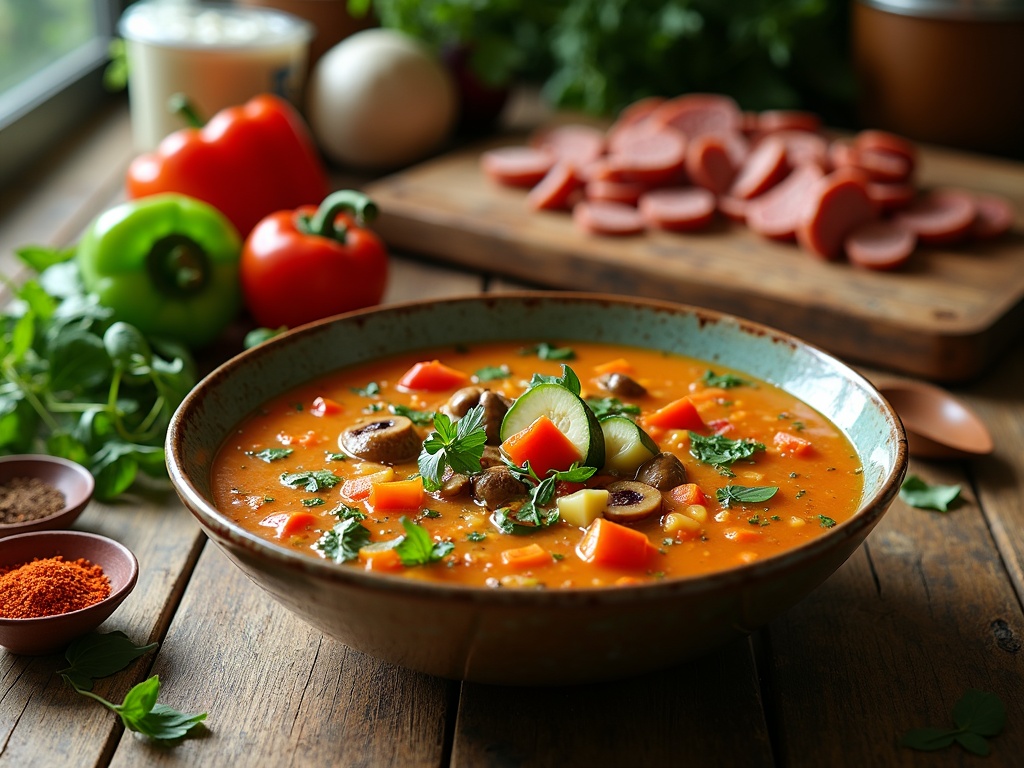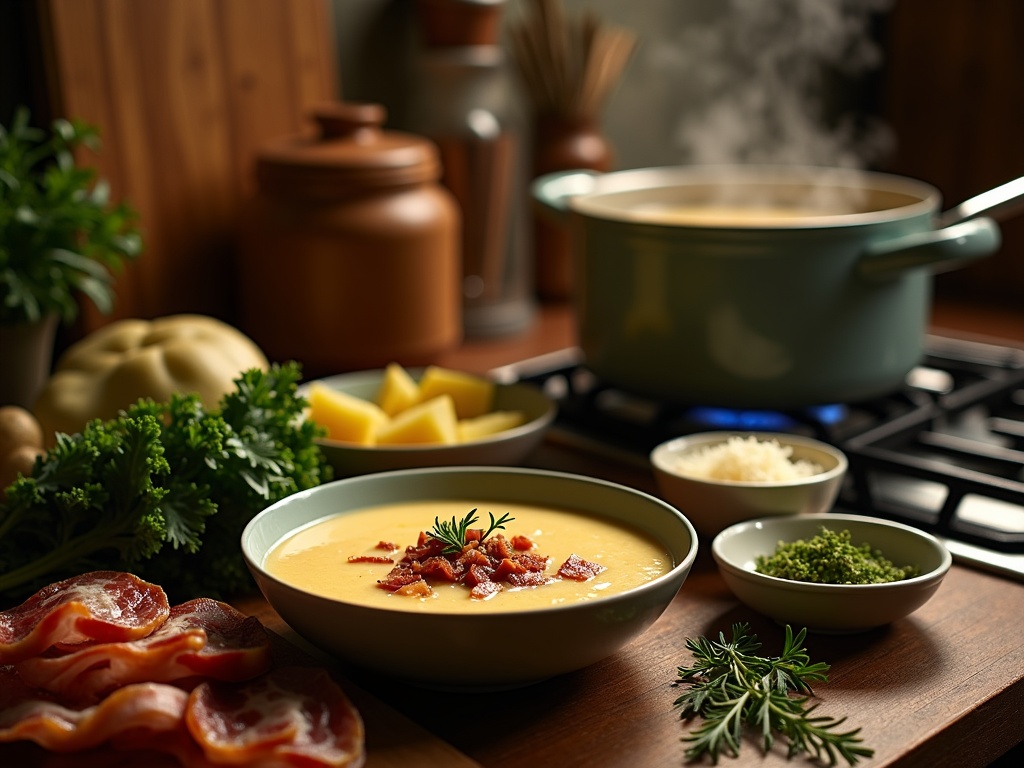Zuppa soup delivers a distinct Italian-inspired experience with its smooth, cream-based texture and savory profile featuring Italian sausage, soft potatoes, and crisp greens. This dish balances indulgence with heartiness, producing restaurant-quality results through straightforward preparation of rich ingredients that create a complete meal in one bowl.
Find In This Article
Key Takeaways
- Italian sausage provides the foundational flavor while potatoes add heartiness and absorb the surrounding flavors throughout the cooking process.
- The signature creamy texture comes from heavy cream added toward the end of cooking, creating a luxurious mouthfeel that distinguishes it from thinner soups.
- Building flavor in layers is crucial—properly browning meats, sautéing aromatics, and seasoning throughout the cooking process develops depth.
- Common mistakes include overcooking kale, adding cream too early, and rushing the cooking process rather than allowing flavors to develop properly.
- The soup is highly adaptable with numerous possible substitutions including different proteins, vegetables, and dairy alternatives to suit dietary preferences.
What Makes Zuppa Soup Special
Zuppa soup stands out in the world of comfort foods with its distinctive creamy texture and savory flavor profile. I’ve found that this Italian-inspired dish captures hearts with its perfect balance of rich ingredients and hearty components that satisfy even the most discerning palates.
The Perfect Combination of Ingredients
The magic of zuppa soup lies in its carefully selected ingredients that create a symphony of flavors in every spoonful. The foundation begins with a velvety, cream-based broth that’s substantially thicker than many other traditional soups you might be familiar with. What truly distinguishes this dish is the addition of Italian sausage—providing a subtle spicy kick that complements the creaminess perfectly.
Potatoes add a substantial heartiness to the soup, absorbing the flavors while contributing a comforting starchiness. Unlike lighter options like gazpacho soup, zuppa embraces richness without apology. The combination of tender potatoes, savory sausage, and that signature cream base creates a texture that’s simultaneously smooth and satisfying with delightful bits of substance throughout.
Many home cooks appreciate that zuppa soup delivers restaurant-quality results without professional training. The soup has gained particular fame as an Olive Garden copycat recipe that loyal fans swear tastes just like the restaurant version—sometimes even better when made with fresh ingredients at home.
What separates zuppa from other soups like corn soup or pea soup is its impressive depth of flavor achieved through relatively simple preparation. The key components work together seamlessly:
- Italian sausage provides savory, seasoned protein
- Potatoes offer hearty texture and absorb surrounding flavors
- Cream creates the signature velvety mouthfeel
- Italian herbs infuse the broth with aromatic complexity
- Kale or spinach (often added) contributes color, texture, and nutrition
I’ve noticed that zuppa soup has a unique ability to feel both indulgent and wholesome simultaneously. It delivers the satisfaction of comfort food while incorporating vegetables and protein, making it more than just a treat—it’s a complete meal in a bowl that can be customized to personal preferences.
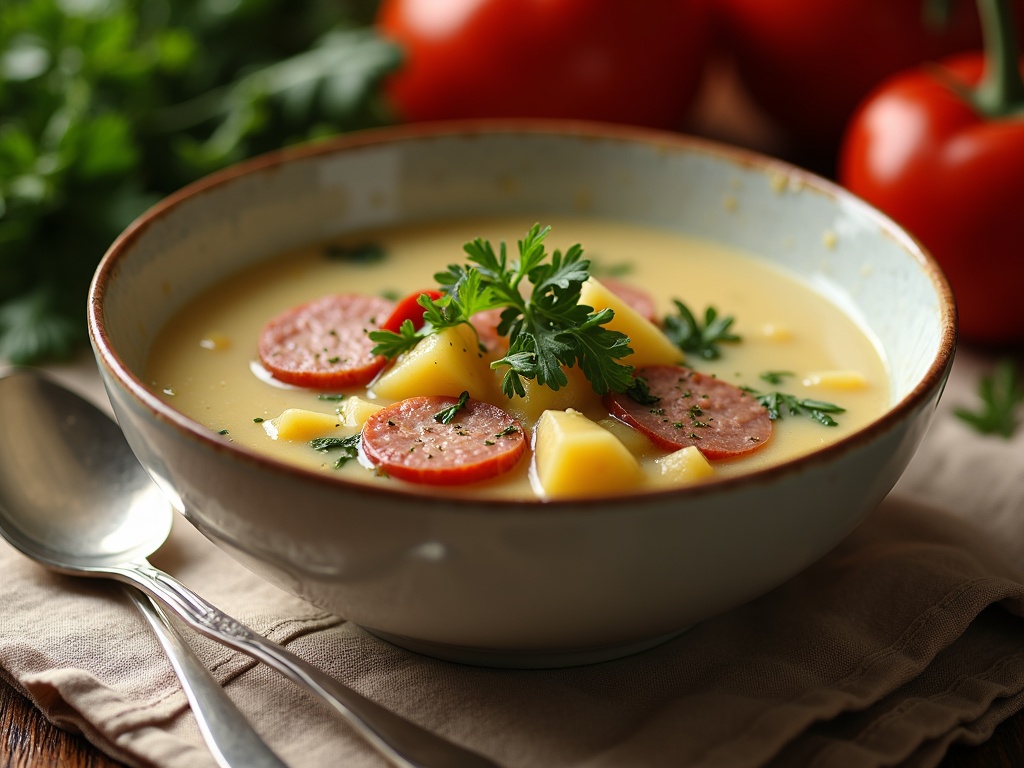
Everything You’ll Need to Make It
Preparing a delicious zuppa soup at home is simpler than you might think. I’ve gathered all the essential ingredients to help you create this hearty Italian favorite right in your kitchen.
Key Ingredients
Italian sausage forms the flavor foundation of any authentic zuppa soup. You can choose either spicy or mild varieties depending on your heat preference. The sausage should be removed from its casing and crumbled before cooking to distribute the flavor evenly throughout the soup.
Russet potatoes add heartiness and substance to the soup. I recommend slicing them into thin, uniform pieces so they cook evenly and absorb the rich flavors of the broth. Their starchy quality helps give the soup its signature thick consistency that’s so satisfying.
Fresh kale brings both nutritional value and a pop of color to your zuppa soup. Make sure to remove the tough stems and tear the leaves into bite-sized pieces. If you enjoy other soups with leafy greens, you might also like homemade carrot soup which offers similar nutritional benefits.
Heavy cream creates that silky, luxurious texture that makes zuppa soup so comforting. Add it toward the end of cooking to prevent curdling, and you’ll achieve that perfect creamy consistency.
Chicken broth serves as the liquid base, providing depth and richness. For the best flavor, I suggest using homemade broth, but a good-quality store-bought version works well too.
Yellow onion and garlic cloves build the aromatic foundation. Finely dice the onion and mince the garlic for the best flavor distribution throughout your soup. These aromatics are similar to those used in traditional corn soup, creating that wonderful kitchen aroma as they sauté.
Bacon strips add a smoky, savory element that complements the sausage perfectly. Cook them until crisp, then crumble them into the soup. The rendered bacon fat can be used to sauté your onions and garlic for an extra flavor boost. For another delicious soup featuring savory elements, try pea soup with beef which offers a similar savory profile.
All-purpose flour helps thicken the soup to achieve that perfect consistency. You’ll want to make a roux with some of the fat from the meat and the flour before adding your liquids.
Salt and pepper are essential for seasoning. I recommend tasting as you go and adjusting to your preference, keeping in mind that the sausage and bacon already contribute saltiness to the dish.
For a refreshing contrast to this hot, hearty soup, you might consider making gazpacho soup in warmer months – it’s served cold and makes a great summer alternative.
The beauty of zuppa soup lies in its straightforward preparation and rich flavors. Once you gather these ingredients, you’ll be ready to create a restaurant-quality soup that’s perfect for cold days or whenever you’re craving something comforting and satisfying. The combination of savory meats, tender potatoes, and fresh kale swimming in a creamy broth creates a meal that’s both filling and flavorful.
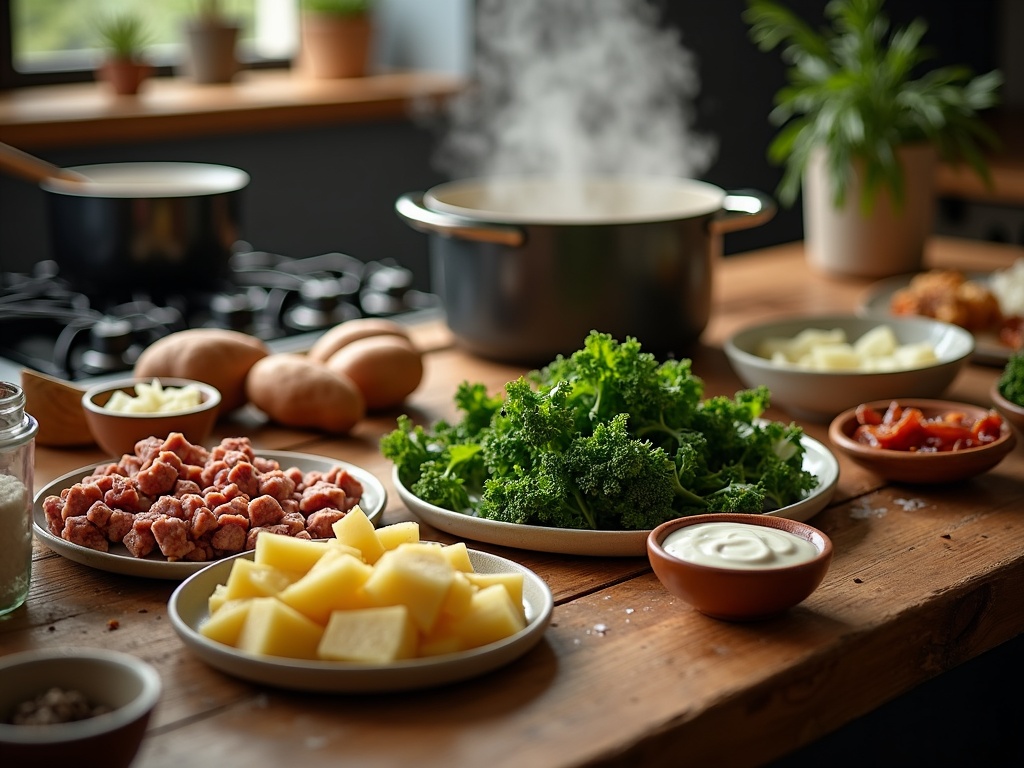
Bringing It All Together
Creating a delicious zuppa soup isn’t as hard as you might think. I’ve broken down the process into simple steps that’ll help you create a restaurant-quality soup right in your kitchen. The key to success lies in building layers of flavor throughout each step of the cooking process.
Building Layers of Flavor
First, I brown the sausage in a large pot over medium-high heat. I make sure to break it up into bite-sized pieces as it cooks. The goal here is to develop a deep caramelization that adds richness to the final soup. Once the sausage is golden brown with crispy edges, I remove it from the pot and set it aside, keeping all those flavorful drippings in the pot.
Next comes the bacon. I cook it separately from the sausage to ensure both meats get proper browning. Overcrowding the pan can lead to steaming rather than browning. Once the bacon is crisp, I transfer it to the same plate as the sausage.
In the same pot with all those wonderful meat drippings, I add diced onions. The onions will soak up all that savory goodness as they soften. After about 5 minutes, I toss in minced garlic and cook for another 30 seconds until fragrant. This aromatic base is similar to what you’ll find in other delicious soups like hearty carrot soup or creamy corn soup.
The roux comes next – I sprinkle flour over the sautéed vegetables and stir constantly for about a minute. This quick cooking removes the raw flour taste while creating a thickening agent for our soup. The roux should look like a paste coating the vegetables.
Now for the liquid component – I slowly pour in chicken broth while whisking continuously to prevent lumps. Once the mixture is smooth, I add diced potatoes and bring everything to a simmer. The potatoes need about 15-20 minutes to become fork-tender.
When the potatoes are cooked through, I lower the heat and pour in the cream. This is where the soup transforms from a broth-based dish to something more luxurious. For a lighter version similar to refreshing gazpacho soup, you could reduce the cream amount.
Fresh kale goes in next, and I stir until it wilts into the soup. Unlike spinach which practically disappears, kale maintains some texture even after cooking. If you prefer a different green, you can substitute it with spinach or even the leafy greens used in traditional pea soup.
Finally, I return the cooked sausage and bacon to the pot, stirring gently to incorporate everything. This step is crucial as it allows the meat to release more flavor into the soup while reheating.
Before serving, I taste the soup and make final seasoning adjustments. Typically, it needs a good pinch of black pepper, but the salt amount depends on how salty your broth and meats were to begin with.
A few tips for success:
- Don’t rush the browning of meats – this develops essential flavor
- Stir the roux constantly to prevent burning
- Allow the soup to rest for 5-10 minutes before serving to let flavors meld
- For a spicier version, add red pepper flakes with the garlic
- Cut potatoes into equal-sized pieces for even cooking
The beauty of zuppa soup is its hearty nature and adaptability. You can adjust the thickness by adding more or less broth, or make it more substantial by increasing the amount of potatoes and meat. The end result should be a creamy, flavorful soup with tender potatoes, wilted greens, and savory meat in every bite.
Common Mistakes to Watch For
Making delicious soup recipes at home can be incredibly rewarding, but zuppa soup in particular comes with its own set of challenges. I’ve made plenty of mistakes while perfecting my zuppa soup recipe over the years, and I’m sharing these pitfalls so you can avoid them on your first try.
Ingredient Preparation Errors
Overcooking the kale is perhaps the most common mistake I see in homemade zuppa soup. Kale should maintain some texture and vibrant color rather than becoming mushy and dull green. I add kale during the final 5-7 minutes of cooking, which gives it just enough time to wilt and soften while preserving its nutritional value and pleasant bite.
Using the wrong potato variety can completely change your soup’s texture. Russet potatoes break down too much and create a cloudy broth, while waxy potatoes like red potatoes hold their shape better. For zuppa soup, I recommend Yukon Gold potatoes as they offer the perfect middle ground – they partially break down to thicken the broth while still maintaining some chunks for texture.
Many cooks forget to drain excess grease after browning the sausage. This extra fat creates an oily layer on top of your soup that’s both unappetizing and can throw off the flavor balance. I always drain my sausage on paper towels before adding it back to the pot, leaving just enough fat to sauté the onions and garlic.
Perfecting soup texture comes down to timing, especially when working with dairy. Adding cream too early is a critical error that can cause it to curdle or reduce too much, losing that silky richness. I always add cream during the last 10 minutes of cooking, after reducing the heat to a gentle simmer. This ensures a smooth, velvety finish without the risk of separation.
Not seasoning throughout cooking leads to flat, one-dimensional flavor. I season in layers – a bit of salt when sautéing vegetables, more when adding broth, and a final adjustment just before serving. This builds depth and brings out the individual flavors of each ingredient in your homemade soup creation.
Technique and Timing Issues
Rushing the base flavors is something I did when I first started making zuppa soup. The foundation of onions, garlic, and herbs needs time to develop. I now spend at least 5-7 minutes sautéing these aromatics until the onions are translucent and fragrant. This initial investment of time pays off enormously in the final flavor profile.
Temperature control matters more than you might think. Many cooks keep their soup at a rolling boil, but this aggressive heat can toughen meat, break down vegetables too quickly, and create a cloudy broth. I maintain a gentle simmer throughout most of the cooking process, which allows flavors to meld while keeping textures intact.
Some recipes call for pre-cooking the potatoes, but I’ve found this leads to inconsistent texture. Instead, I add diced potatoes directly to the simmering broth and let them cook until just tender. This gives me better control over their doneness and helps them absorb the soup’s flavors.
Impatience during the final resting period can rob your soup of its best potential. I always let my zuppa soup stand for 10 minutes off the heat before serving. This brief rest allows flavors to settle and marry, creating a more harmonious and satisfying bowl. This small step makes a remarkable difference in the depth and integration of flavors.
Skipping the garnish might seem like a minor oversight, but a sprinkle of freshly grated Parmesan and cracked black pepper adds the perfect finishing touch that elevates homemade zuppa from good to memorable. These final flourishes shouldn’t be considered optional – they’re essential to the complete experience.
Pro Tips for the Perfect Bowl
I’ve been making zuppa soup for years, and it’s the little details that transform a good soup into an exceptional one. These pro tips will help you master this Italian-inspired classic with minimal effort.
Mastering the Technique
Cutting potatoes uniformly is crucial for a perfectly balanced zuppa soup. I recommend chopping them into 1/2-inch cubes to ensure they cook at the same rate. Nothing ruins a soup faster than finding some potato pieces mushy while others remain rock-hard! This technique applies to other vegetables too, creating a more consistent texture throughout your carrot soup or zuppa varieties.
Fresh kale makes a world of difference compared to frozen. The texture remains firmer during cooking, and the flavor stays bright and vibrant. I add it in the last 5-10 minutes of cooking to maintain its nutritional value and prevent it from becoming too soft.
Need to adjust the thickness? Simply add extra broth until you reach your desired consistency. If you prefer a creamier version similar to corn soup, you can add a splash of heavy cream or half-and-half in the final minutes of cooking.
One of my favorite approaches is making zuppa soup ahead of time. The flavors develop beautifully overnight in the refrigerator, similar to how gazpacho soup intensifies with time. When reheating, do it gently over medium-low heat to prevent the cream from separating and the potatoes from breaking down.
For a stunning presentation and flavor boost, garnish with crispy turkey bacon bits just before serving. The crunchy texture creates a delightful contrast to the creamy soup base. Other great garnish options include:
- Fresh herbs like basil or thyme,
- A drizzle of extra virgin olive oil,
- A sprinkle of grated Parmesan cheese – elements that would also enhance a pea soup variation.
These small but significant adjustments transform an ordinary zuppa soup into a restaurant-quality dish that will impress even the most discerning guests. The beauty of these tips is their simplicity – they require minimal extra effort but deliver maximum impact in your final bowl.
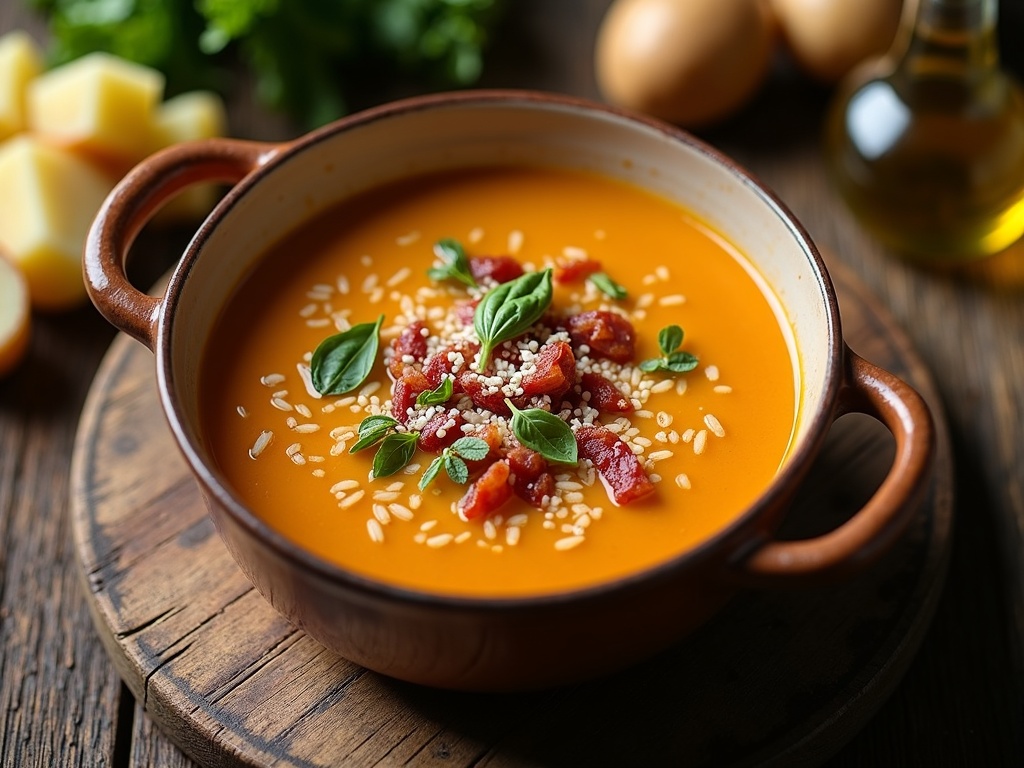
Storage and Reheating Guide
Properly storing and reheating zuppa soup can make all the difference between enjoying restaurant-quality leftovers and dealing with a disappointing meal. I’ve perfected these techniques through years of making this Italian favorite at home, and I’m excited to share my best practices with you.
Refrigeration Tips
Zuppa soup stays fresh in the refrigerator for 3-4 days when stored correctly. After cooking, I always let my soup cool to room temperature before transferring it to airtight containers. This step prevents condensation from forming inside the container, which can water down your soup and affect its texture.
Here are some essential refrigeration practices I follow:
- Use shallow containers rather than deep ones to help the soup cool evenly and quickly
- Leave a small gap at the top of each container to allow for slight expansion
- Label containers with the date to track freshness
- Store soup away from strong-smelling foods as zuppa can absorb other aromas
For cream-based zuppa variations like creamy carrot zuppa, I find the flavor actually improves after a day in the refrigerator as the ingredients have more time to meld together.
Freezing Methods
For longer-term storage, freezing is your best option, and zuppa soup freezes beautifully for up to 3 months. The key tip I’ve discovered is to freeze the soup without adding cream. Dairy products tend to separate when frozen and reheated, resulting in a grainy texture that diminishes the soup’s quality.
When preparing zuppa for freezing, I first cool it completely in the refrigerator. Then I portion it into freezer-safe containers or heavy-duty freezer bags. For quick thawing, I sometimes freeze soup flat in freezer bags, which creates thin, easy-to-thaw packages that take up less space.
This method works particularly well for broths and clear soups like gazpacho soup or corn zuppa variations, though the freezing approach differs slightly for each.
Reheating Techniques
Reheating zuppa soup requires patience and gentle heat to preserve its flavors and textures. I always reheat slowly on the stovetop over medium-low heat, stirring occasionally to ensure even warming. This gradual approach prevents scorching and helps maintain the integrity of the ingredients.
For refrigerated zuppa:
- Place in a saucepan over medium-low heat
- Stir gently every few minutes
- Heat until just beginning to simmer (avoid rapid boiling)
- Add a splash of broth if the soup has thickened too much during storage
For frozen zuppa, I recommend thawing overnight in the refrigerator before reheating. If you’re short on time, you can place the frozen container in a bowl of warm water to loosen the edges, then transfer the frozen block to a pot with a splash of broth to help it melt evenly.
The final crucial step when reheating previously frozen zuppa is adding fresh cream during the reheating process rather than before freezing. I typically wait until the soup is fully heated through, then reduce the heat to low and stir in the cream gradually. This creates the same velvety texture as freshly made soup without the risk of separation or curdling.
This technique works wonderfully with most cream-based soups, including pea soup variations where you can add the dairy element fresh during reheating.
Make It Your Own
The beauty of zuppa soup lies in its versatility. I’ve discovered numerous ways to customize this Italian favorite based on personal preferences, dietary needs, and whatever ingredients happen to be available in my kitchen.
Creative Substitutions
When making zuppa soup at home, I often substitute spinach for kale depending on what looks fresher at the market. Spinach offers a milder flavor and softer texture, making it perfect for those who find kale’s texture too fibrous. It also cooks much faster, reducing preparation time significantly. For a heartier green option similar to traditional carrot soup recipes, chopped collard greens work wonderfully too.
Turkey sausage makes an excellent alternative to traditional Italian sausage for a lighter version with less fat. I’ve found that the soup maintains its satisfying flavor profile while becoming more heart-healthy. Ground chicken can work in a pinch as well, though you might want to add extra herbs to compensate for the milder flavor.
Heat lovers can customize their soup by adding red pepper flakes during the cooking process. I typically start with half a teaspoon and adjust upward based on preference. For a more complex heat, try adding a diced jalapeño or a dash of hot sauce just before serving your gazpacho-inspired hot soup.
Vegetable Variations
I’ve found that zuppa soup serves as an excellent canvas for using extra vegetables from your refrigerator. Some vegetables that pair particularly well include:
- Bell peppers (any color) for sweetness and vitamin C
- Mushrooms for earthy flavor and meaty texture
- Zucchini or yellow squash for summer freshness
- Celery for aromatic depth
- Leeks as a milder alternative to onions
Adding extra vegetables not only enhances nutritional value but creates a more visually appealing soup with varied textures and colors. When incorporating additional vegetables, I add firmer vegetables like carrots early in the cooking process and save tender ones like zucchini for the last few minutes to prevent overcooking.
For a corn-forward variation, adding fresh or frozen corn kernels brings natural sweetness and pleasant texture contrast, similar to what you might find in a classic corn soup but with Italian flair.
Making zuppa soup dairy-free doesn’t mean sacrificing creaminess. I substitute coconut cream for heavy cream with excellent results. The subtle coconut flavor complements the savory elements surprisingly well. Other alternatives include cashew cream, which offers a neutral flavor base, or unsweetened almond milk thickened with a tablespoon of cornstarch.
For those avoiding legumes, swap out the traditional white beans for diced potatoes to maintain heartiness. The starch from the potatoes will naturally help thicken the soup slightly, similar to how it works in hearty pea soup recipes.
The broth itself offers another opportunity for customization. While chicken broth serves as the traditional base, vegetable broth creates a delicious vegetarian version. For deeper flavor, I sometimes use half broth and half water with additional herbs and a splash of white wine.
Lastly, don’t forget the power of garnishes to make each bowl unique. Fresh herbs like basil or oregano, a drizzle of quality olive oil, homemade croutons, or a sprinkle of dairy-free cheese can elevate your personalized zuppa soup to restaurant quality with minimal effort.
